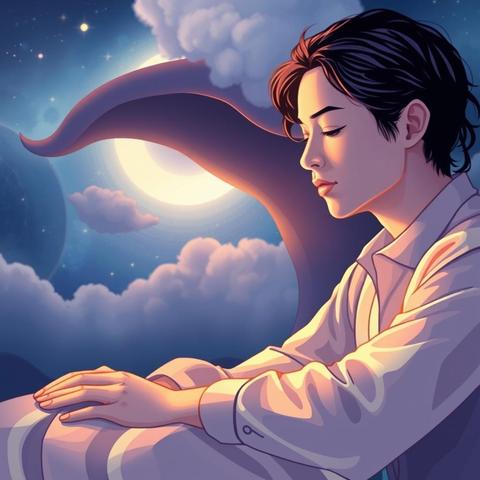Have you ever woken up from a vivid dream, feeling the lingering emotions so intensely that they seem to bleed into your waking life? I remember a dream I had years ago – a recurring one, in fact – where I was endlessly climbing a steep staircase, never reaching the top. It felt exhausting, frustrating, and left me with a sense of unease throughout the day. It wasn’t until I started exploring the science of sleep and the power of dream interpretation that I realized this recurring dream reflected my own feelings of striving for an elusive goal in my career. Understanding my sleep cycles and the dreams within them was the key to unlocking that meaning. Many of us share this curiosity – we wonder about the hidden messages within our dreams, and what those nocturnal journeys reveal about ourselves. This article delves into the fascinating world of sleep cycles and dream interpretation, empowering you to understand your own dreams and unlock their profound potential.
The Science Behind Our Sleep Cycles
Our sleep isn’t a monolithic state; instead, it’s a dynamic process cycling through distinct stages throughout the night. Understanding these cycles is crucial to understanding the context of our dreams. These stages are characterized by unique brainwave patterns, physiological changes, and dream experiences.
Stage 1: The Transition Phase
This initial stage is the transition from wakefulness to sleep. It’s a brief period where brainwave activity slows down, and you may experience hypnic jerks (those sudden muscle twitches) or fleeting images. Dreams in this stage are usually fragmented and less vivid.
Stage 2: Light Sleep
Stage 2 constitutes the bulk of our sleep time. Brainwave activity slows further, characterized by sleep spindles (bursts of rapid brainwave activity) and K-complexes (sharp, high-amplitude waves). While dreams may occur, they’re often less memorable than those of later stages.
Stage 3 and 4: Deep Sleep (Slow-Wave Sleep)
These stages mark our deepest sleep, crucial for physical restoration and growth hormone release. Brainwave activity is slow and rhythmic (delta waves). Dreams are less frequent in these stages, and if they occur, they tend to be less vivid and more difficult to recall.
REM (Rapid Eye Movement) Sleep: The Dream Factory
REM sleep is characterized by rapid eye movements, increased brain activity resembling wakefulness, and vivid, often bizarre dreams. This is where the most memorable and emotionally charged dreams typically occur. Muscle paralysis prevents us from acting out our dreams during this stage, protecting us from harm. The REM stage becomes progressively longer throughout the night.
- Sleep Apnea and Its Treatment: A Comprehensive Guide to Restful Nights
- The Importance of Napping: Unveiling the Power of Brief Slumbers
- Stress and Sleep: Unlocking the Secrets of Your Restless Nights
- Sleep and Mental Health: Unlocking the Power of Dreams for Improved Well-being
- Technology and Sleep: How Our Devices Impact Our Dreams and Dream Therapy
The Relationship Between Sleep Cycles and Dreaming
Dreams aren’t randomly scattered throughout the night; they’re intricately tied to our sleep cycles. While dreams can happen in any stage, the most vivid and memorable ones typically occur during REM sleep. The length and frequency of REM cycles increase throughout the night, meaning the later part of your sleep is often richer with dream experiences.
Dream Recall and Sleep Cycles
The likelihood of remembering a dream depends on several factors, including when you wake up. Waking up during or shortly after a REM cycle significantly increases the chance of recalling your dream. If you awaken during a non-REM stage, you’re less likely to remember any dreams you experienced.
The Emotional Impact of Dreams
Dreams can evoke a wide range of emotions, from joy and excitement to fear, anxiety, and sadness. These emotions are not arbitrary; they often reflect our subconscious processing of daily experiences, unresolved conflicts, and emotional baggage. Understanding the emotions associated with your dreams is a key to unlocking their meaning.
Understanding the Symbolic Language of Dreams

Dreams don’t always communicate in literal terms. They often employ symbolism, a language unique to the individual dreamer’s experiences and subconscious.
Common Dream Symbols and Their Interpretations
Many symbols appear frequently in dreams, carrying universal or culturally shared meanings. For example:
- Flying: Often symbolizes freedom, independence, or escaping limitations.
- Falling: Can represent feelings of loss of control, insecurity, or inadequacy.
- Water: Frequently symbolizes emotions, unconscious feelings, or the flow of life.
- Teeth falling out: This common dream often represents anxieties about appearance, aging, or loss of power.
- Being chased: May indicate avoidance of responsibilities, unresolved conflicts, or feelings of being overwhelmed.
However, these are just general interpretations. The true meaning of a symbol depends heavily on the individual’s personal associations and the context of the entire dream.
The Importance of Context in Dream Interpretation
The specific details of your dream, such as the setting, characters, and emotions involved, are crucial for accurate interpretation. A dream about being chased in a dark forest carries a different meaning than being chased in a brightly lit park. The emotions you experience within the dream – fear, joy, confusion – provide valuable clues to its underlying message.
The Hidden Meanings Behind Your Dreams

Dreams act as a window into your subconscious, revealing thoughts, feelings, and experiences that may be hidden from your conscious awareness. They’re not simply random images; they’re meaningful messages your mind is trying to communicate.
Uncovering Personal Themes and Conflicts
Repeated themes in your dreams often highlight areas of conflict, unresolved issues, or recurring patterns in your waking life. For instance, repeatedly dreaming about being lost might suggest feelings of directionlessness or uncertainty in your life. Paying attention to these recurring motifs can provide valuable insights into your subconscious.
Dreams as a Path to Self-Discovery
Dream analysis can be a powerful tool for self-discovery. By exploring the symbolism and emotions within your dreams, you can gain a deeper understanding of your values, beliefs, and aspirations. This self-reflection can lead to positive changes and personal growth.
Common Variations and Themes in Dreams
The way a specific symbol or theme manifests in a dream can vary greatly, adding layers of complexity to interpretation.
Variations on Common Dream Symbols
Consider the dream of flying. A joyful, effortless flight suggests freedom and empowerment. A terrifying, uncontrolled fall from the sky might indicate anxiety and loss of control. The specific nuances of the dream drastically alter the interpretation.
Emotional Cues Within Dreams
The emotions you experience within the dream are pivotal. A dream about a loved one passing away can be incredibly sad, yet it might also offer solace or peace. The intensity and type of emotion present give profound insight into the subconscious message.
The Interpretation and Deeper Message of Dreams

The ultimate goal of dream interpretation isn’t just to understand the literal meaning of the symbols, but to grasp the deeper message the dream is trying to convey.
Lessons and Messages from Dreams
What is your subconscious trying to tell you? Are there unresolved conflicts that need attention? Is it highlighting a pattern of behavior you need to address? Dreams often offer guidance and solutions you might not see in your waking state.
Dreams and the Search for Inner Peace
Sometimes, dreams act as a pathway to inner peace. They may offer insights into your spiritual journey, guiding you towards self-acceptance and emotional healing.
Practical Advice for Dreamers
Turning dream analysis into a practice can be remarkably empowering.
Keeping a Dream Journal
Detailed recording of your dreams, including emotions and sensory details, creates a rich archive for reflection and analysis.
Connecting Dreams to Personal Values
How do your dreams reflect your core values and beliefs? Examining this connection can illuminate your priorities and guide your decision-making.
Incorporating Meditation or Therapy
Meditation can enhance dream recall and improve awareness of your inner self. Dream therapy provides a professional framework for exploring these deeper meanings within a safe and supportive environment.
Conclusion
Understanding your sleep cycles and the dreams they contain is a journey of self-discovery. It’s about recognizing the profound messages your subconscious communicates through this nocturnal language. By paying attention to the details, emotions, and recurring themes, you can unravel the hidden meanings and gain valuable insights into your life. At Dream Therapy Now, we specialize in helping individuals unlock the power of their dreams through expert analysis, sleep science, and therapeutic practices. Let us guide you on your path to clarity, transformation, and a deeper understanding of yourself. Contact us today at info@dreamtherapynow.com to embark on this transformative journey.
Dive into our blog to discover a wealth of content that will illuminate the significance of your nocturnal adventures and guide you through the labyrinth of dream symbolism. Impeccable Dream hopes this guide was helpful! If you want to see other blog posts about Sleep Disorders, here are some that may be of interest to you.